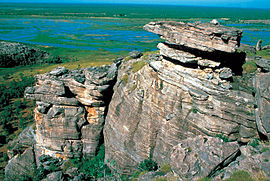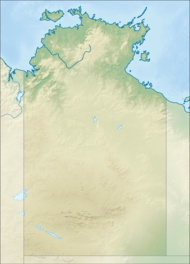
Back টপ এন্ড Bengali/Bangla Top End Catalan Top End Danish Top End German Supra Pinto EO Top End Spanish تاپ اند FA Top End French Top End ID トップエンド Japanese
This article needs additional citations for verification. (January 2007) |
| Top End Northern Territory | |||||||||
|---|---|---|---|---|---|---|---|---|---|
 Sandstone outcrop and wetlands in Kakadu National Park | |||||||||
 A NASA satellite image of the Top End | |||||||||
| Coordinates | 13°23′S 132°58′E / 13.39°S 132.96°E | ||||||||
| Area | 245,000 km2 (94,595.0 sq mi) | ||||||||
| Time zone | ACST (UTC+09:30) | ||||||||
| |||||||||
The Top End of Australia's Northern Territory is a geographical region encompassing the northernmost section of the Northern Territory, which aside from the Cape York Peninsula is the northernmost part of the Australian continent. It covers a rather vaguely defined area of about 245,000 square kilometres (95,000 sq mi) behind the northern coast from the Northern Territory capital of Darwin across to Arnhem Land with the Indian Ocean on the west, the Arafura Sea to the north, and the Gulf of Carpentaria to the east, and with the almost waterless semi-arid interior of Australia to the south, beyond the huge Kakadu National Park.[1]
The Top End contains the Territory's regional center and its capital city, Darwin, as well as major towns such as Palmerston and Katherine. The well-known town of Alice Springs is located further south, in the arid southern part of the Northern Territory, sometimes referred to by Australians as the Red Centre.
The landscape is relatively flat with river floodplains and grasslands with eucalyptus trees along with rocky areas and patches of rainforest, and in western Arnhem Land a high rugged sandstone plateau cut through with gorges, much of which is in Kakadu National Park. The rivers that form the wetlands include the South and East Alligator Rivers, Mary River, and the Glyde River. The climate is tropical monsoon with a wet and dry season, bringing the highest rainfall in northern Australia (over 1,200 mm (47 in) per year). Temperatures do not fluctuate widely throughout the year.
There are a number of islands off the Top End coast including the Tiwi Islands (Bathurst Island and Melville Island), and Groote Eylandt as well as many smaller ones.
- ^ Rosauer, D.F.; Blom, M.P.K.; Bourke, G.; Catalano, S.; Donnellan, S.; Gillespie, G.; Mulder, E.; Oliver, P.M.; Potter, S.; Pratt, R.C.; Rabosky, D.L.; Skipwith, P.L.; Moritz, C. (December 2016). "Phylogeography, hotspots and conservation priorities: an example from the Top End of Australia" (PDF). Biological Conservation. 204: 83–93. Bibcode:2016BCons.204...83R. doi:10.1016/j.biocon.2016.05.002. Archived from the original (PDF) on 13 August 2018. Retrieved 12 August 2018.
